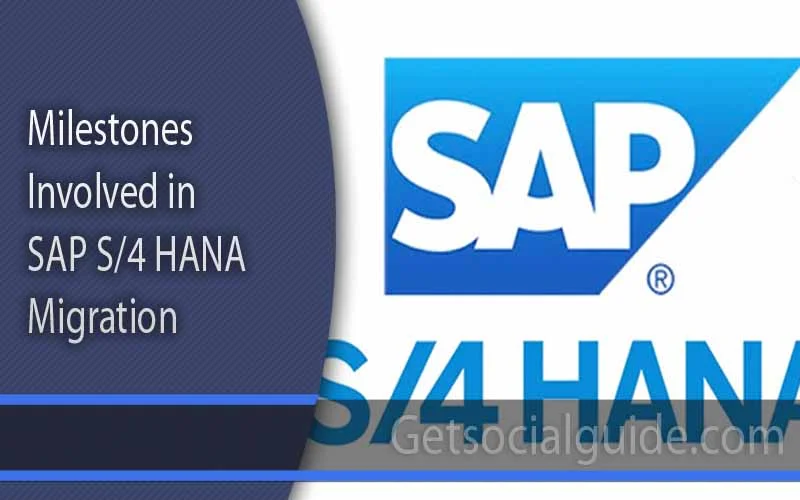Milestones Involved in SAP S/4 HANA Migration – Full Guide
Migrating to a robust ERP solution such as SAP S/4 HANA can bring many challenges as well as opportunities for an organization. However, as long as you can leverage an appropriate approach for the migration, things can go very well without any complications.
SAP S/4 HANA migration is not something that must be planned as an update or upgrade of the existing business operations. Instead, it is the entirely new rejuvenation of all business processes to help your business drive better and more effective results.
That being said, there are a couple of milestones involved in SAP S/4 HANA migration, and knowing them can be very helpful for ensuring a smooth migration. Therefore, let’s check them out one at a time.

Sizing the HANA Landscape Precisely
One of the essential milestones involved in SAP S/4 HANA migration is to create an ideal technical project plan. This will help your organization realize the maximum benefit from the investment while reducing the long-term total cost of ownership. The amount of the actual data stored in memory determines the sizing of the SAP HANA database.
It is difficult to guess the approximate memory required as the data in the SAP HANA database is compressed. The memory sizing can be aided by the use of relevant SAP notes, Sizing reports, and the SAP Quick Sizer tool.
Therefore, one must adhere to the following steps to size their HANA landscape accurately. These steps include:
- Sizing of memory for dynamic and static data
- Sizing of CPU for calculations queries and transactions
- Sizing of Sisk for persistent storage
Transform SAP S/4 HANA Roadmap into Concrete Plans
The next milestone that you need to be wary about is turning your SAP S/4 HANA roadmap into an actionable plan that can benefit your organization. There is much documentation made available by SAP that your organization can use to choose a roadmap that best suits your needs and requirements.
Different businesses have different needs and requirements, and these documentations will help you address all these requirements and facilitate a successful deployment for better results. Further, divide your migration roadmap into different phases for better implementation with minimal risks of failure.
This is important because SAP S/4 HANA migration will impact every department within the business, and breaking down the migration into different phases offers better chances for a successful implementation.
Carry Out Gap Analysis
When an organization is in the discovery phase of its SAP S/4 HANA migration, it is ideal to evaluate different strong and weak points on SAP S/4 HANA. This makes gap analysis vital for the SAP S/4 HANA migration process.
This gap analysis can help your organization better decide the components that can be deployed faster and earlier compared to components that can wait for the time being. Taking this realistic approach can be very helpful in terms of identifying and mitigating the risk factors associated with SAP S/4 HANA migration.
For instance, a gap analysis can help your organization better leverage the machine learning and analytical competencies of SAP S/4 HANA across varied departments within the organization.
Understanding the Importance of Data in Initial Stages of SAP S/4 HANA Migration
Data is by far one of the most important factors when it comes to migrating to a new ERP solution. However, very often, businesses fail to realize the significance of data in the initial stages of migration. This should not be the case, as failing to understand the importance of data can result in adverse consequences throughout the migration process.
Even most prominent SAP experts recommend starting the migration roadmap with data at the center of it all. This can help one get an understanding of the different data requirements of the business and augment the roadmap accordingly to best serve the requirements of the business. In addition, this is the most effective way to leverage the full potential of the finance-related features and functionalities within SAP S/4 HANA.
Selecting the Appropriate Platform and Strategy
Choosing the right platform that best suits your business’s needs, resources, and budget can help you migrate to SAP S/4 HANA seamlessly. SAP S/4 HANA deployments are generally available in two types: on-premise deployment and cloud deployment.
On-premise deployment refers to a preconfigured approach that offers a solution based on validations by both the hardware vendor and SAP. Meanwhile, a cloud deployment is implemented mainly through SAP HANA Enterprise Cloud, which includes a software license, cloud infrastructure, and other services managed by SAP.
After settling on a deployment scenario, it is vital to select the most effective migration strategy to avoid unforeseen technical issues. Two of the most common migration strategies are classical migration and DMO or Database Migration Option.
Classical migration is most effective when you are migrating your BW system or Business Suite to SAP S/4 HANA as it does not require any additional components. However, DMO requires less manual effort as compared to classical migration. It is most preferable for companies that run on standard SAP processes and are planning to migrate to SAP S/4 HANA with a smaller data footprint.
In Conclusion – Milestones Involved in SAP S/4 HANA Migration
Your ERP implementation is something that can either make or break your business. Therefore, it always helps to keep oneself updated with all the necessary milestones involved in the SAP S/4 HANA migration process to ensure better chances of good results. Therefore, leverage this information mentioned above and facilitate a seamless migration without any complications.
Author Bio: Eric Smith is an SAP professional providing consulting services for SAP solutions to his clients. With a knack for technology, he loves to write on the latest SAP developments and share his knowledge with the readers.



